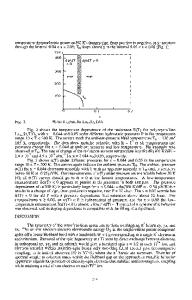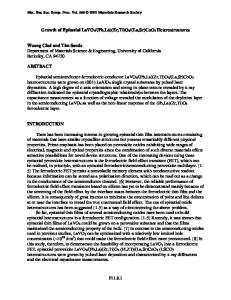Thermoelectric Study on Polycrystalline La 1-x Sr x RuO 3
- PDF / 299,978 Bytes
- 6 Pages / 612 x 792 pts (letter) Page_size
- 37 Downloads / 528 Views
0886-F02-03.1
THERMOELECTRIC STUDY on POLYCRYSTALLINE La1-xSrxRuO3 Jian He, D. Thompson, B. Edwards and Terry M. Tritt Department of Physics and Astronomy, Clemson University, Clemson, SC 29631 ABSRACT The polycrystalline samples of the orthorhombic perovskite La1-xSrxRuO3 (0.1≤x≤0.9) have been prepared by conventional solid state chemistry reactions. The phase constituents, composition homogeneity and micro-morphology were measured by X-ray powder diffraction, Energy Disperse X-ray spectroscopy and scanning electron microscopy. Subsequently, the materials were then characterized by means of the electrical resistivity, thermal conductivity and thermopower measurements. In particular, the temperature and composition dependence of thermopower was approached in light of the spin-entropy model proposed by W. Koshibae et al. for the strongly correlated system, NaxCoO4. INTRODUCTION Good thermoelectric (TE) materials incorporate good electrical conductivity, high thermopower and low thermal conductivity. Accordingly, the oxides were believed to make poor TE materials due to the carrier mobility being orders of magnitude lower than that of practical TE materials. One reason is the considerable electronegativity difference among the constituent elements that leads to more ionic-like bonding, large charge transfer and strong scattering of carriers by optical phonons. Even for the metallic oxide, the thermopower is often found to be trivial due to complex band structure. That is why the simultaneous reduction of resisitivty and enhancement of thermopower found in metallic NaxCoO2 is so peculiar and enlightening in pursuing novel mechanism(s) in TE materials [1]. As one of the theoretical efforts, Koshibae et al. proposed that the large thermopower of NaxCoO2 could be originated from the large spin degeneracy of Co ions and strong correlation effect among 3d electrons [2]. It was concluded into a generalized Heikes formula as shown in Equation (1):
α=
k B ⎡ ⎛ g3 ⎞ x ⎤ ln ⎢ ⎥ e ⎣ ⎜⎝ g4 ⎟⎠ (1 − x ) ⎦
(1)
where α is the thermopower in the high temperature limit, kB Boltzmann constant, e carrier charge, g3(g4) the degree of degeneracy of Co3+(Co4+) and x the concentration of Co4+. Structure-wise, each Co ion is octahedrally coordinated by 6 O, the d-orbital is split into eg and t2g subsets. The spin configuration of 3d electrons on each Co site is hence dictated by the competition among on-site Coulomb interaction, crystal field and Hund’s rule. As the result, Co 3+(Co4+) can adopt low-spin, intermediate-spin and high-spin states
0886-F02-03.2
with the electronic configurations t2g6 (t2g5), t2g5eg (t2g4eg) and t2g4eg2 (t2g3eg2), respectively. The large difference in the spin and orbital degrees of freedom between Co3+ and Co4+ add extra entropy to the carrier moving from one site to another and gives rise to the observed large values of thermopower. Similar consideration has been applied to the 3d Cobalt oxide perovskite La1-xSrxCoO3 [3] and in turn prompts the present study on the 4d perovskite La1-xSrxRuO3. Except for th
Data Loading...











